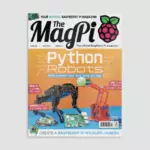The MagPi regular and Raspberry Pi guide writer, Sean has done just about everything with a Raspberry Pi. This #MagPiMonday, we get to know him better and take a walk down memory lane to the early days of Raspberry Pi.

If you’ve been reading The MagPi for a while, you’ll have seen many excellent tutorials from the pen (keyboard?) of Sean McManus. Writing tutorials about games, image manipulation, Scratch stuff, AI storybooks, and much more, there’s a reason he’s also one of the writers behind Raspberry Pi for Dummies.
“I tend to make educational projects, from which readers can learn something about programming,” Sean says to us. “I started in the 1980s, writing programs on the Amstrad CPC 464. Some appeared as listings in magazines, including a sprite toolkit that retro developers still use sometimes. I lost touch with programming as a hobby for a few years, but the Raspberry Pi reawakened my interest and made it easy to get back into. I learned Scratch, Python, and Sonic Pi with it, and built some simple electronics projects.”

When did you learn about Raspberry Pi?
There was a bit of a buzz online about Raspberry Pi before it launched. I was one of the people who ordered stickers to support the project before the first model went on sale. I ordered a Raspberry Pi Model B as soon as I could, and attended a talk at Google Campus in 2012 where I asked Eben to sign the box (which I still have). The early machines were excellent value and great to experiment with. It’s been amazing to see how the performance has increased over the years.

How did you start writing about Raspberry Pi?
In the early days of the Raspberry Pi there wasn’t the ecosystem that exists today, and the software wasn’t quite as friendly as it is now, either. Friends told me they’d bought a Raspberry Pi computer but didn’t really know how to use it, or what to do with it. I had been writing books for Wiley’s Older and Wiser series, so I pitched the idea of a Raspberry Pi book, which ended up becoming Raspberry Pi For Dummies, co-written with Mike Cook. It was one of the first books about Raspberry Pi, and is now in its fourth edition.

What is your favourite thing to write about related to Raspberry Pi?
I like creating projects that people can easily customise or learn from. ArtEvolver (The MagPi 119), for example, enables anyone to make their own digital artwork by simply curating the images they feed it. Similarly, people can personalise Raspberry Radio (The MagPi 122) with their own music and DJ banter. My book Mission Python featured a space game where readers can modify the maps and puzzles. The idea is to provide an easy way in for people to start tinkering and creating something unique. At the same time, those who want to do more with the code can find Python functions to do things like download RSS feeds, implement computer speech, or index a folder of files. I hope people see bits of my code and think: ‘Aha! I can use that!’
What are some of your favourite projects that you’ve made with Raspberry Pi?
I enjoyed building the graphic adventure game Escape, which featured in the book Mission Python. It shows readers how to go beyond small examples in Python to build a more substantial game. I love Scratch, and one of my favourite projects is Throttle and Tilt. It’s a car racing game I wrote to showcase the new features in Scratch 3 (The MagPi 86). You use a Sense HAT as a steering wheel. I created a few Scratch projects that work with 3D red/cyan glasses, where the depth is part of the gameplay. In 12 Angry Aliens, the aliens fly towards you out of the screen.
The MagPi #132 out NOW!
You can grab the brand-new issue right now from Tesco, Sainsbury’s, Asda, WHSmith, and other newsagents, including the Raspberry Pi Store in Cambridge. It’s also available at our online store which ships around the world. You can also get it via our app on Android or iOS.

You can also subscribe to the print version of The MagPi. Not only do we deliver it globally, but people who sign up to the six- or twelve-month print subscription get a FREE Raspberry Pi Pico W!
The free PDF will be available in three weeks’ time. Visit the issue page for more details.









